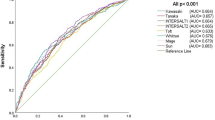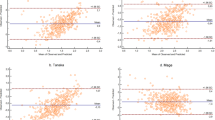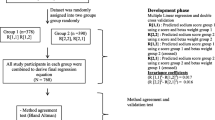Abstract
Purpose
A variety of prediction equations have been able to estimate 24-h urinary sodium excretion from spot urine samples; however, Iranians over the age of 50 have not been compared and verified. Using spot urine samples as a substitute for 24-h urine samples to estimate 24-h urine sodium excretion among the population age 50 and older are the purpose of this study.
Methods
A 24-h urinary sodium excretion was studied by well-known Kawasaki, INTERSALT, Tanaka, and World Health Organization/Pan American Health Organization (WHO/PAHO) formulas. On 360 individuals, the mean bias, agreements between estimated and measured values, correlation, absolute and relative differences, and misclassification rates were evaluated for four equations.
Results
As a result, the mean urinary sodium excretion for a 24-h period was 136.3 ± 52.21 mmol/24-h, which corresponds to a calculated intake of 9.1 ± 3.8 g of salt per day. According to the WHO/PAHO formula, the mean bias between measured values and estimated 24-h urinary sodium excretion is − 21.6 mg/day (95% confidence interval (CI) − 144.8, 101.6 mg/day), which is the smallest difference compared with the other three formulas. The lowest rate of individual misclassification of salt intake was 40% for WHO/PAHO, especially for those who consumed less than 9 g/day, while Kawasaki had the lowest misclassification rate at higher levels of salt intake.
Conclusion
As a result of our research, the WHO/PAHO equations accurately predict 24-h urinary sodium excretion among Iranians aged ≥ 50 more than other equations, both at the population level and at the individual level. However, further study is needed in regard to different ages in Iran.




Similar content being viewed by others
Data availability
The data that support the findings of this study are available from the corresponding author upon reasonable request.
References
Cappuccio FP (2013) Cardiovascular and other effects of salt consumption. Kidney Int Suppl 3:312–315
He FJ, Burnier M, Macgregor GA (2011) Nutrition in cardiovascular disease: salt in hypertension and heart failure. Eur Heart J 32:3073–3080
World Health Organisation (2018) The top 10 causes of death. WHO Press
Lim SS, Vos T, Flaxman AD, Danaei G, Shibuya K, Adair-Rohani H et al (2012) A comparative risk assessment of burden of disease and injury attributable to 67 risk factors and risk factor clusters in 21 regions, 1990–2010: a systematic analysis for the Global Burden of Disease Study 2010. Lancet (Lond, Engl) 380:2224–2260
Omidi N, Arabloo J, Rezapour A, Alaeddini F, Bragazzi NL, Pourasghari H et al (2021) Burden of hypertensive heart disease in Iran during 1990–2017: findings from the Global Burden of Disease study 2017. PLoS ONE 16:e0257617
Gakidou E, Afshin A, Abajobir AA, Abate KH, Abbafati C, Kaja MA (2017) Global, regional, and national comparative risk assessment of 84 behavioural, environmental and occupational, and metabolic risks or clusters of risks, 1990–2016: a systematic analysis for the Global Burden of Disease Study 2016. Lancet (Lond, Engl) 390:1345–1422
Forouzanfar MH, Liu P, Roth GA, Ng M, Biryukov S, Marczak L et al (2017) Global burden of hypertension and systolic blood pressure of at least 110 to 115 mm Hg, 1990–2015. JAMA 317:165–182
Irazola VE, Gutierrez L, Bloomfield G, Carrillo-Larco RM, Dorairaj P, Gaziano T et al (2016) Hypertension prevalence, awareness, treatment, and control in selected LMIC communities: results from the NHLBI/UHG network of centers of excellence for chronic diseases. Glob Heart 11:47–59
World Health Organization (2012) A comprehensive global monitoring framework including indicators and a set of voluntary global targets for the prevention and control of noncommunicable diseases. World Health Organization, Geneva
Popkin BM (2006) Global nutrition dynamics: the world is shifting rapidly toward a diet linked with noncommunicable diseases. Am J Clin Nutr 84:289–298
McLean RM, Farmer VL, Nettleton A, Cameron CM, Cook NR (2018) Twenty-four-hour diet recall and diet records compared with 24-hour urinary excretion to predict an individual’s sodium consumption: a systematic review. J Clin Hypertens (Greenwich) 20:1360–1376
Ji C, Sykes L, Paul C, Dary O, Legetic B, Campbell NR et al (2012) Systematic review of studies comparing 24-hour and spot urine collections for estimating population salt intake. Pan Am J Public Health 32:307–315
Cogswell ME, Maalouf J, Elliott P, Loria CM, Patel S, Bowman BA (2015) Use of urine biomarkers to assess sodium intake: challenges and opportunities. Annu Rev Nutr 35:349–387
McLean RM (2014) Measuring population sodium intake: a review of methods. Nutrients 6:4651–4662
Tanaka T, Okamura T, Miura K, Kadowaki T, Ueshima H, Nakagawa H et al (2002) A simple method to estimate populational 24-h urinary sodium and potassium excretion using a casual urine specimen. J Hum Hypertens 16:97–103
Kawasaki T, Itoh K, Uezono K, Sasaki H (1993) A simple method for estimating 24 h urinary sodium and potassium excretion from second morning voiding urine specimen in adults. Clin Exp Pharmacol Physiol 20:7–14
Brown IJ, Dyer AR, Chan Q, Cogswell ME, Ueshima H, Stamler J et al (2013) Estimating 24-hour urinary sodium excretion from casual urinary sodium concentrations in Western populations: the INTERSALT study. Am J Epidemiol 177:1180–1192
WHO (2010) WHO/PAHO Regional Expert Group for cardiovascular disease prevention through population-wide dietary salt reduction. Protocol for population level sodium determination in 24-hour urine samples Geneva. WHO Press
Aminisani N, Azimi-Nezhad M, Shamshirgaran SM, Mirhafez SR, Borji A, Poustchi H et al (2022) Cohort profile: the Iranian Longitudinal Study on Ageing (IRLSA): the first comprehensive study on ageing in Iran. Int J Epidemiol 51:e177–e188
Zhang JY, Yan LX, Tang JL, Ma JX, Guo XL, Zhao WH et al (2014) Estimating daily salt intake based on 24 h urinary sodium excretion in adults aged 18–69 years in Shandong, China. BMJ Open 4:e005089
Stolarz-Skrzypek K, Kuznetsova T, Thijs L, Tikhonoff V, Seidlerová J, Richart T et al (2011) Fatal and nonfatal outcomes, incidence of hypertension, and blood pressure changes in relation to urinary sodium excretion. JAMA 305:1777–1785
Koo TK, Li MY (2016) A guideline of selecting and reporting intraclass correlation coefficients for reliability research. J Chiropr Med 15:155–163
Gholami A, Ghanbari A, Rezaei S, Baradaran HR, Khatibzadeh S, Parsaeian M et al (2022) National and sub-national trends of salt intake in Iranians from 2000 to 2016: a systematic analysis. Arch Public Health 80:120
Zhang X, Liao H, Ye R, Li X, Gou Q, Zhang Z et al (2021) Assessment and validation of three spot urine assay methods for the estimation of 24-hour urinary sodium excretion in Chinese Tibetan adults living in the mountains. J Clin Hypertens (Greenwich) 23:1588–1598
Zhou L, Tian Y, Fu JJ, Jiang YY, Bai YM, Zhang ZH et al (2017) Validation of spot urine in predicting 24-h sodium excretion at the individual level. Am J Clin Nutr 105:1291–1296
Peng Y, Li W, Wang Y, Chen H, Bo J, Wang X et al (2016) Validation and assessment of three methods to estimate 24-h urinary sodium excretion from spot urine samples in Chinese adults. PLoS ONE 11:e0149655
Xu J, Du X, Bai Y, Fang L, Liu M, Ji N et al (2020) Assessment and validation of spot urine in estimating the 24-h urinary sodium, potassium, and sodium/potassium ratio in Chinese adults. J Hum Hypertens 34:184–192
McLean R, Williams S, Mann J (2014) Monitoring population sodium intake using spot urine samples: validation in a New Zealand population. J Hum Hypertens 28:657–662
Doenyas-Barak K, Beberashvili I, Bar-Chaim A, Averbukh Z, Vogel O, Efrati S (2015) Daily sodium and potassium excretion can be estimated by scheduled spot urine collections. Nephron 130:35–40
Mizéhoun-Adissoda C, Houehanou C, Chianéa T, Dalmay F, Bigot A, Preux PM et al (2016) Estimation of daily sodium and potassium excretion using spot urine and 24-hour urine samples in a black population. J Clin Hypertens (Greenwich) 18:634–640
Swanepoel B, Schutte AE, Cockeran M, Steyn K, Wentzel-Viljoen E (2018) Monitoring the South African population’s salt intake: spot urine v. 24 h urine. Public Health Nutr 21:480–488
Charlton K, Ware LJ, Chidumwa G (2020) Prediction of 24-hour sodium excretion from spot urine samples in South African adults: a comparison of four equations. J Hum Hypertens 34:24–33
Cogswell ME, Wang CY, Chen TC, Pfeiffer CM, Elliott P, Gillespie CD et al (2013) Validity of predictive equations for 24-h urinary sodium excretion in adults aged 18–39 y. Am J Clin Nutr 98:1502–1513
Rezaei S, Mahmoudi Z, Sheidaei A, Aryan Z, Mahmoudi N, Gohari K et al (2018) Salt intake among Iranian population: the first national report on salt intake in Iran. J Hypertens 36:2380–2389
Vidal-Petiot E, Joseph A, Flamant M (2017) Estimation of populational 24-h urinary sodium and potassium excretion from spot urine samples: evaluation of four formulas in a large national representative population. J Hypertens 35:1119–1120
Rhee MY, Kim JH, Shin SJ, Gu N, Nah DY, Hong KS et al (2014) Estimation of 24-hour urinary sodium excretion using spot urine samples. Nutrients 6:2360–2375
Ma W, Yin X, Zhang R, Liu F, Yang D, Fan Y et al (2017) Validation and assessment of three methods to estimate 24-h urinary sodium excretion from spot urine samples in high-risk elder patients of stroke from the rural areas of Shaanxi province. Int J Environ Res Public Health 14:1211
Vidal-Petiot E, Joseph A, Resche-Rigon M, Boutten A, Mullaert J, Mullaer MP et al (2018) External validation and comparison of formulae estimating 24-h sodium intake from a fasting morning urine sample. J Hypertens 36:785–792
Xu J, Zhang J, Liu M, Bai Y, Guo X, Dong J et al (2020) Estimating 24-hour sodium excretion from spot urine samples in chinese adults: can spot urine substitute 24-hour urine samples? Nutrients 12:798
Han W, Sun N, Chen Y, Wang H, Xi Y, Ma Z (2015) Validation of the spot urine in evaluating 24-hour sodium excretion in chinese hypertension patients. Am J Hypertens 28:1368–1375
Mill JG, Rodrigues SL, Baldo MP, Malta DC, Szwarcwald CL (2015) Validation study of the Tanaka and Kawasaki equations to estimate the daily sodium excretion by a spot urine sample. Braz J Epidemiol 2:224–237
Mann SJ, Gerber LM (2010) Estimation of 24-hour sodium excretion from spot urine samples. J Clin Hypertens (Greenwich) 12(3):174–180
Funding
This study was financially supported by Neyshabur University of Medical Sciences (Grant number: 98-011-22. Ethical code: IR.NUMS.REC.1398.032.
Author information
Authors and Affiliations
Corresponding author
Ethics declarations
Conflict of interest
The authors have no conflicts of interest to declare.
Supplementary Information
Below is the link to the electronic supplementary material.
Rights and permissions
Springer Nature or its licensor (e.g. a society or other partner) holds exclusive rights to this article under a publishing agreement with the author(s) or other rightsholder(s); author self-archiving of the accepted manuscript version of this article is solely governed by the terms of such publishing agreement and applicable law.
About this article
Cite this article
Hariri, M., Ramezani, A.M., Shamshirgaran, S.M. et al. Is a spot urine sample a good substitution to estimate 24-h urinary sodium excretion in a population ≥ 50 years old? A validation study. Eur J Nutr 62, 3277–3286 (2023). https://doi.org/10.1007/s00394-023-03217-6
Received:
Accepted:
Published:
Issue Date:
DOI: https://doi.org/10.1007/s00394-023-03217-6




